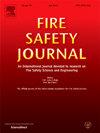B-LDPE管在正常和超重力下近极限向下/反向火焰蔓延、火焰锋面振荡和极限氧浓度
IF 3.4
3区 工程技术
Q2 ENGINEERING, CIVIL
引用次数: 0
摘要
实验研究了不同重力、不同氧浓度和不同相对流速下火焰在圆柱形热塑性材料上的近极限向下蔓延。对不锈钢(SS)和铜(Cu)芯的黑色低密度聚乙烯管进行了测试。测量了火焰蔓延速率(FSR)和极限氧浓度(LOC)等关键参数,并利用连续小波变换对火焰振荡进行了分析。结果表明,对于ss岩心样品,重力拉伸效应降低了火焰温度,减弱了滴落效应;在实控线附近很少发生滴漏。FSR和LOC的变化趋势与吹落理论一致。振荡火焰前缘的主导频率随重力的增大而增大,而振幅随水滴长度的缩短而减小。对于铜核样品,金属核远没有熄灭,而是作为热源,增强了滴水和FSR,特别是在超重力条件下。在LOC附近,cu核转变为散热器,因此火焰流相互作用开始主导FSR。Cu-core样品LOC高于SS-core样品,且随重力和反向流动的增加更为温和。在超重力状态下,火焰振荡由于更强的滴流而更强烈,但在LOC附近变得不那么重要。这项研究提供了对热塑性材料可燃性的见解,有助于航天器的消防安全。本文章由计算机程序翻译,如有差异,请以英文原文为准。
Near-limit downward/opposed flame spread, flame front oscillation and limiting oxygen concentration of B-LDPE tube in normal- and hypergravity
Near-limit downward flame spread over cylindrical thermoplastic materials under various gravities, oxygen concentrations and opposed flow velocities were investigated experimentally. Black low-density polyethylene tubes with stainless-steel (SS) and copper (Cu) cores were tested. Key parameters, including flame spread rate (FSR) and limiting oxygen concentration (LOC), were measured, and flame oscillations were analyzed using continuous wavelet transforms. Results show that, for SS-core samples, gravity-induced stretch effects reduce the flame temperature, weakening the dripping effect. Dripping seldom occurs near LOC. The trends of FSR and LOC are consistent with blow-off theory. The dominant frequency for oscillatory flame front increases with gravity, while the amplitude decreases owing to shorter dripping lengths. For Cu-core samples, far from extinction, the metal core acts as a heat source, enhancing dripping and FSR, especially in hypergravity. Near the LOC, the Cu-core shifts to a heat sink, thus the flame-flow interaction begins to dominate the FSR. LOC for Cu-core sample is higher than that for SS-core sample, and increases more mildly with gravity and opposed flow. Flame oscillations are more intense in hypergravity due to a stronger dripping flow, but it becomes less important near LOC. This study provides insights into the flammability of thermoplastic material, contributing to fire safety in spacecraft.
求助全文
通过发布文献求助,成功后即可免费获取论文全文。
去求助
来源期刊

Fire Safety Journal
工程技术-材料科学:综合
CiteScore
5.70
自引率
9.70%
发文量
153
审稿时长
60 days
期刊介绍:
Fire Safety Journal is the leading publication dealing with all aspects of fire safety engineering. Its scope is purposefully wide, as it is deemed important to encourage papers from all sources within this multidisciplinary subject, thus providing a forum for its further development as a distinct engineering discipline. This is an essential step towards gaining a status equal to that enjoyed by the other engineering disciplines.
 求助内容:
求助内容: 应助结果提醒方式:
应助结果提醒方式:


